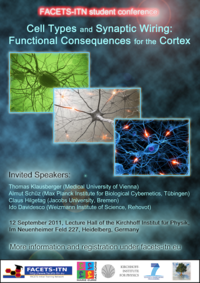PAST -- Student conference on 12 September 2011: Cell Types and Synaptic Wiring: Functional Consequences for the Cortex[]
The FACETS-ITN student conference Cell Types and Synaptic Wiring: Functional Consequences for the Cortex took place on Monday, 12 September 2011 in Heidelberg at the Kirchhoff Institute for Physics (located here).
For accommodation, please check Heidelberg Tourismus
Conference description:
The cerebral cortex of the mammalian brain is involved in all stages of information processing, from integrating sensory input with memories to decision making and motor action. Believed to be a prerequisite for intelligent behavior, it is considered to be the most complex computational device known so far.
Cortical function relies on a large number of small computational building blocks, the neurons, which operate in parallel and communicate through synaptic connections. At first sight, cortical tissue looks like a homogeneous substrate. However, a closer look reveals a variety of morphologically different cell types, with diverse intrinsic dynamics and response characteristics. Likewise, rich structures are found in the synaptic connectivity patterns -- both locally between nearby neurons, as well as in long-range projections which transmit information between distant cortical areas.
The FACETS-ITN student conference overviews distinct features of all major neuronal cell types and summarizes ubiquitous local and global motifs of synaptic wiring in the cortex. In addition, it aims to explore functional implications of the observed cortical network architecture. Ample time is dedicated to discussions with the speakers to understand their view on cortical computation and its anatomical foundations.
- Conference agenda
- Registration for the conference: The registration deadline for the conference expired.



